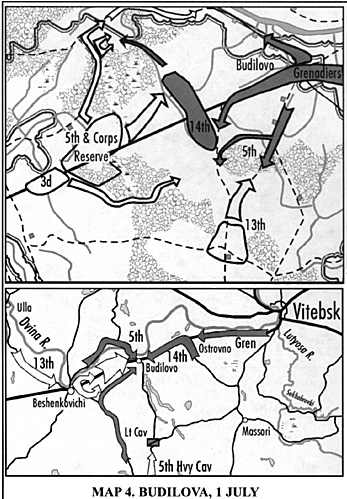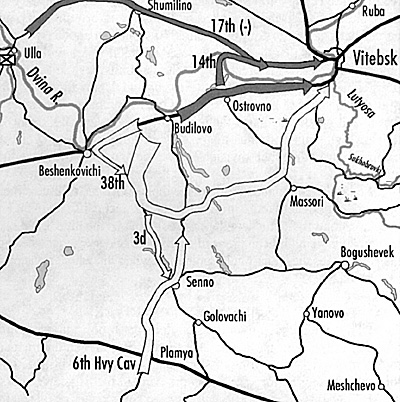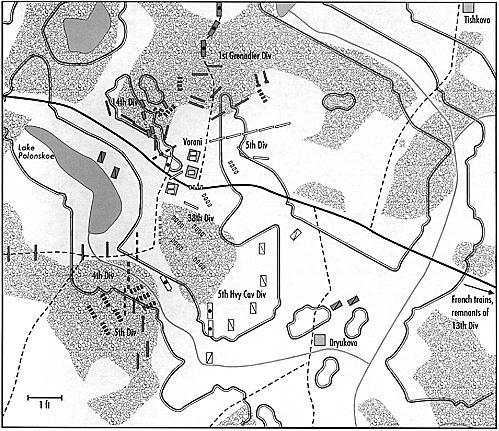Struggle at Budilovo
The French clearly had the momentum at this point. They had managed to stay a step ahead of the Russians, and now had a nearly 50% numerical advantage in infantry at Budilovo. The Russians had plenty of artillery, however, which was to prove crucial. The Russians chose to defend an open area with woods on each flank. The French attack plan was complicated, with four separate elements. [MAP 4]
 Budilovo, 1 July: As the defeated Russians fall back from Beshenkovichi, both sides concentrate on Budilovo where the Russian 14th Division has established defensive positions. It is re-inforced by the 5th Division which has nearly reached Beshenkovichi via the north bank of the Dvina before turning back. The three-pronged French attack becomes uncoordinated and Russian artillery chews up the central attack. The 1st Grenadiers arrive just in time, intending to counterattack the French 13th. Instead they are forced to countermarch to halt a flanking march by the French 5th Division that threatens to turn the Russian right and rear.
Budilovo, 1 July: As the defeated Russians fall back from Beshenkovichi, both sides concentrate on Budilovo where the Russian 14th Division has established defensive positions. It is re-inforced by the 5th Division which has nearly reached Beshenkovichi via the north bank of the Dvina before turning back. The three-pronged French attack becomes uncoordinated and Russian artillery chews up the central attack. The 1st Grenadiers arrive just in time, intending to counterattack the French 13th. Instead they are forced to countermarch to halt a flanking march by the French 5th Division that threatens to turn the Russian right and rear.
The attack became uncoordinated and the main pinning element in the center was badly mauled by concentrated artillery fire. Even so, the Grenadier Division arrived just in time to halt a flanking move that threatened to turn the Russian right and rear as an evening fog settled in.
Weather is handled by our tactical rules. There is a die roll for each day, with possible additional rolls to determine the times of onset and cessation of rain and other events. Most days in the summer were clear, with one that was hot and humid (reducing march speeds), a couple with morning or evening fog, and one with light showers for three hours. None of this had a critical effect on the campaign. In fact, I have never had weather be a major factor in a campaign, perhaps because we have always fought in the standard campaigning seasons. It adds flavor, though, and takes very little time to handle, so I have kept it in the game. I roll up all the weather for three weeks before we start, and just give the players the weather as it happens.
Each side now learned that the French had mounted an assault on Polotsk and failed. Bagration had withdrawn on Orsha, and looked like continuing to Smolensk. Barclay ordered the Russian commander to hold the Gorodok-Vitebsk-Smolensk road open for his own withdrawal. Napoleon anticipated an attack on Orsha on the 5th or 6th, and ordered the French commander to block Barclay's anticipated move to Smolensk.
Giving the players information about the world to their flanks can help keep them believing in the plausibility of the campaign, and acts as a mechanism to focus the action where you have designed it to be. It lets you play a campaign that gives the commanders some flexibility of independent action but doesn't require playing the entire theatre. The French considered renewing their attack on Budilovo, but decided not to do so, even though the Wurtemburgers had finally caught up. The Russians considered counterattacking the next morning, but decided that it was too dangerous and instead began a slow, staged withdrawal on Ostrovno. At this point, I was anticipating a battle at Ostrovno, where the Russians had historically made a stand, but the French fooled me ... and the Russians.
A Clever Maneuver, and a Disaster
As the Russians began to carefully withdraw, the French had already begun to break contact. In a very effective maneuver, they moved out of contact, then bypassed Ostrovno to the South, marching directly on Vitebsk. The Russians assumed that they were pulling back to Beshenkovichi, and failed to press the French cavalry screen, completely losing contact. [Map 5]
 Around to Vitebsky: 2-5 July: The French break contact after Budilovo, bypass Ostrovno to the south, and march on Vitebsk. French cavalry distracts the Russians, who lose contact completely until they get reports of enemy troops in Massori.
Around to Vitebsky: 2-5 July: The French break contact after Budilovo, bypass Ostrovno to the south, and march on Vitebsk. French cavalry distracts the Russians, who lose contact completely until they get reports of enemy troops in Massori.
By 5 July the Russians had reports of the enemy moving north of Massori. The had begun to withdraw towards Vitebsk when the head of their column from Ostrovno observed the French already approaching the Lutyosa crossing to Vitebsk. Unfortunately, their lead unit is the battered 4th Division, on its way to Vitebsk to rest and refit, and completely unable to launch an attack on its own.
While the Russians frantically tried to concentrate, the French launched an attack on the city off the march. Vitebsk was held only by the jager remnants of the 17th Division newly arrived from Ulla and a militia garrison, and part of the city walls are in disrepair. The French 13th Division assaulted the south gate of the city, its strongest point, and failed to take it by coup de main, nearly destroying itself in the attempt.
This was probably the critical turning point of the campaign. The French felt pressured to take the city before the Russians could form to drive them off and did not scout the city, so they never noticed the sections with broken walls or without defenders. The tactical rules we use make an assault on fortified walls absolutely brutal, even when the defenders are under-strength militia, and we hadn't played any such assaults in our one-of games. The French badly underestimated the difficulty of the attack on which they embarked, and although they nearly pulled it off anyway, the cost was high enough to lose them the operational initiative. The French drew off from the city, moving to the East.
The Final Battle
Both armies were now in a precarious position. The French were East of Vitebsk, across the Russian LOC. The Russians were simultaneously across the French LOC. The French decided that Napoleon would have a decisive result at Orsha in the next day or so, and that they would find a good defensive position across the Smolensk road and hold on until he arrived. They drew off East to the hamlet of Voroni.
In one early campaign I ran, I was fresh from reading Martin van Creveld's Logistics and War, and came up with a set of rules that tracked supply generation and gathering, foraging and transportation, depots and LOC troops. This is important stuff, it can easily determine the success or failure of a real campaign, and I found it fascinating. However it turns out to be important only on a longer time scale and larger geographic scale than shows up in this sort of campaign. I have instead found it works best to insist loudly that the commanders maintain their LOCs, assume that the troops have three days hard rations with them, and make vague but ominous noises about what will happen to them if their LOC is cut. So far, it's had the desired effect: the players really do worry about their supply lines.
The Russians were now prepared to try to attack and clear the road. While the French 6th Heavy Cavalry Division held off the remnants of 17th Division Southwest of the field of battle, both commanders committed everything they had available [Map 6].
The difficult terrain and a three-pronged attack plan led to three separate attacks on the French. The Russians ran out of strength just short of breaking the French. Both sides were now spent. The outcome of the war may depend on whether Bagration stood at Orsha, and whether Barclay or Napoleon reaches Vitebsk first.
Map 6:
The Wurtemburgers were driven back, but will reform on the French left supported by the cavalry. The Russian Grenadier Division has made it slong flank march, fought its way through the woods and is beginning its attack on the French right. The initial Russian attack north of the road has faltered. By the time it can be re-inforced, the other attacks will lose their impetus.

More Napoleonic 1812 Campaigning
Back to Table of Contents -- Courier #78
To Courier List of Issues
To MagWeb Master Magazine List
© Copyright 2000 by The Courier Publishing Company.
This article appears in MagWeb (Magazine Web) on the Internet World Wide Web.
Other military history articles and gaming articles are available at http://www.magweb.com